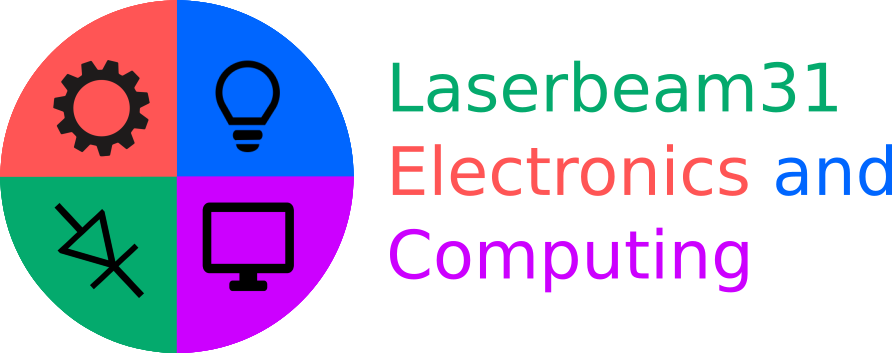
Theatre Lighting Intro: Software 2
[Theatre Lighting Contents Page]As has already been established in previous sections, ultimate control of theatrical lights and other DMX devices rests with the central control console. It is therefore the case that knowledge of the principles of operation of such consoles is essential.
In spite of the fact that this chapter is part of the Software section of the guide, it is not necessarily the case that all lighting consoles are digital. Certainly, it is now commonplace for theatres to operate using a fully computerised lighting console which can easily create the multiplexed data necessary for a DMX universe, but older consoles intended for use with analogue (non-DMX) dimmer packs such as those discussed in the former half of the Hardware 3: Lighting Dimmers chapter are often simply a set of potentiometers linked back to triac dimmer circuits, often with little or no active electronics present in the console itself; a console of this sort simply exists such that the potentiometer sliders are all grouped together in one place to offer convenient and compact control of all the channels of dimming. Analogue consoles typically have no provision for controlling any advanced devices such as those discussed in Hardware 5: Advanced DMX Devices and are intended to be used exclusively with simple dimmed incandescent lights.
The most basic type of lighting controller simply consists of a row of sliders. In such a basic arrangement, each slider controls one dimmed channel on the backstage dimmer pack. By moving a slider up or down, the intensity of a particular channel (fixture) may be raised or lowered. Below is shown a six-channel DMX controller of this kind:
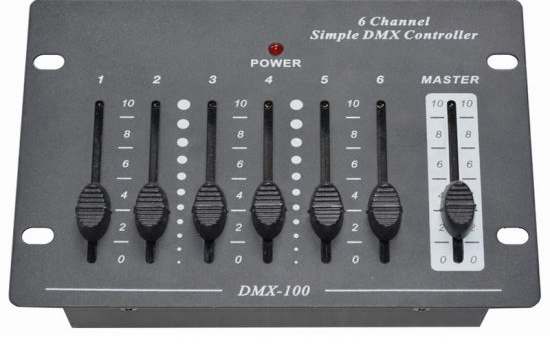
In this picture, one will notice the extra rightmost "master" slider. This is similar to the "master volume" on a stereo and allows for the overall control of the intensity of all channels simultaneously. For example, one may set each left-hand slider to a desired level and then adjust the overall intensity of all channels up or down using the master control.
These consoles are limited for control of show lighting owing to their inability to store any preset "scenes" - sets of pre-stored lighting levels - which may be changed by the push of a single button or slider. Instead, the intensity has to be controlled "live" by adjusting each individual slider as and when changes are required. Such controllers are, however, occasionally used in place of conventional room light switches in venues where it is desirable to dim the standard room lighting or to control various sections of the room's lights individually. The room lights are then dimmed by separate standard theatrical dimmer packs positioned in a discrete location.
[Top of Section] [Top of Page] [Theatre Lighting Contents]
Preset consoles, the next step up from those described in the previous section, offer the ability for two separate scenes of lighting to be set up on two different banks of sliders. A "crossfade" between the scenes may be made by using a separate slider, similar to a master.
The major advantage of preset consoles is that they allow for the "storage" of a lighting scene other than that which is currently active. These consoles typically have two rows of sliders, one for the first available scene and another for the second scene. An operator can set up a scene on one row of sliders which is output live to a set of dimmed channels. However, whilst this scene is live, another scene for the same range of channels may be set up on the second row of sliders. This second scene is not output live until the main crossfade slider is slid to its opposite end of travel such that the original scene fades out and the new scene fades in. Once the new scene from the second slider row is live, the original row of sliders may be set to the levels for a third scene. The master crossfade slider may then be readjusted such that the first row once again becomes live and the second row may be edited for the next scene. This process can be repeated infinitely.
Below is shown a preset console (analogue Tempus desk from Strand Electric) such as that described in the above paragraph:
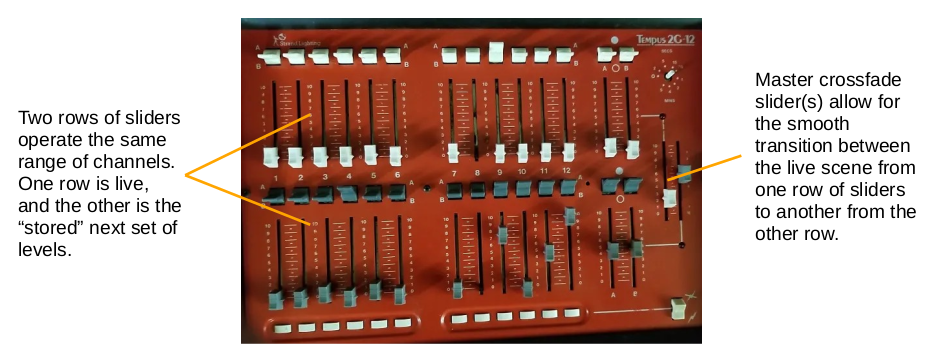
Preset consoles are vastly superior to the most basic controllers discussed in the section prior to this one. However, they still rely on adjusting sliders during a show: while one scene is live, the operator is inputting the levels for the next scene into the alternative row of sliders. This reliance on the live adjustment of sliders makes simple preset consoles such as the above Strand Tempus console unsuitable for very rapid bursts of scene changing since such changes would not allow the operator the necessary interim period to set the levels for the next scene, even though the actual crossfade itself is only governed by a single slider, or pair thereof.
As a result of the above issues with preset consoles - most of which are not greatly computerised, other than the inclusion of a DMX XLR communications port on more modern types - there exist further improved consoles which allow for the digital storage of an essentially infinite number of pre-programmed lighting scenes, each of which may then be recalled by the push of a button, with no need to adjust any sliders at all during a show.
[Top of Section] [Top of Page] [Theatre Lighting Contents]
Cue storage consoles are computerised to the degree that they can store a great many individual scenes of lighting in solid-state memory. These scenes can then be recalled and output to a DMX (or, in rare cases, analogue) universe of control as and when they are required simply by pushing a cue button. Many storage control desks, such as the Zero88 Alcora or Jester also have a set of conventional sliders for the initial programming of lighting scenes, or "cues", during technical rehearsal periods.
In the programming mode of operation, scenes are inputted to the sliders on the console or set via a digital keypad/keyboard and then stored to the console's internal memory such that they can then be recalled without adjusting any sliders during a show. In the playback mode of operation, the individual scene cues can then be selected and made live by simply pushing a cue key.
Digital storage consoles often have a number of additional features compared with simple preset consoles:
Below is shown a common digital storage console (Zero88 Jester):
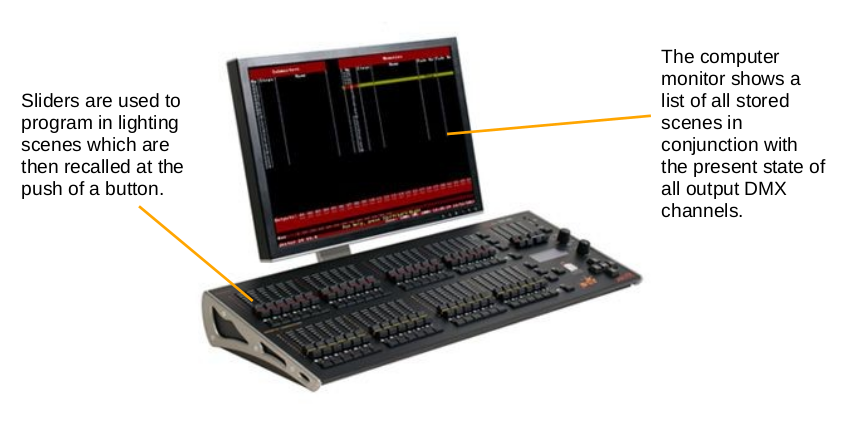
[Top of Section] [Top of Page] [Theatre Lighting Contents]
Lighting consoles which operate over DMX are also used to control numerous advanced devices other than simple single-parameter dimmed fixtures. Examples of such advanced devices include moving-head lights, LED lights, colour scrollers, and smoke machines.
Even if a basic DMX console is intended to exclusively control simple dimmed fixtures, it is often possible to use its output signals to control other devices as well. For example, a console may be configured such that three of its dimmer sliders are DMX-addressed to the three parameters of an LED fixture - red, green, and blue - instead of the intended conventional dimmer channels. Thus, by altering the level of each of these three sliders, any output colour may be achieved from the corresponding LED fixture: each slider simply outputs a 0-255 DMX signal on a particular address which is universally recognisable by any DMX-enabled device. In this way, it is often possible to control many different sorts of DMX devices from a standard console.
A further example would be a remote relay module. As discussed in S1.5 - DMX Addressing of Relay Modules, the numerical DMX input for the address corresponding to the relay is divided into two equal ranges such that if the signal is in one range the relay switches on; if it is in the other, it switches off. If a desk slider were mapped to a relay, the response point at which the relay switches on/off would be located at the centre of the slider's travel such that the slider can act as a switch of sorts.
However, moving-head lights may present problems when operated exclusively from sliders. This is owing to the fact that they utilise "pan" and "tilt" parameters in conjunction with simple intensity, colour, or speed control such as would be the case for other DMX devices (e.g. colour scrollers and smoke machines). Certainly, a moving-head light's pan/tilt could be controlled from a pair of sliders, each outputting a 0-255 signal for the different pan and tilt addresses of the fixture as discussed in S1.3 - DMX Addressing of Moving-Head Fixtures. However, such control may prove unintuitive owing to the use of a linear slider to control a rotational parameter. It is therefore preferable, if large numbers of moving-head lights are to be controlled, to utilise a console with dedicated encoder wheels. These are rotary knobs whose rotation corresponds to that of the pan/tilt of the fixture being programmed. Typically, these wheels may be used to program the movement of a moving-head light into a digital console's internal storage such that the movement may be replayed during a show through the transmission of a sequence of adequate DMX signals stored in the console's memory.
Below is a close-up photograph of a set of rotary encoder wheels on a console intended to control moving-head lights (Zero88 Solution). These are used during the programming process to load movements which will be replayed during a show as part of scenes:
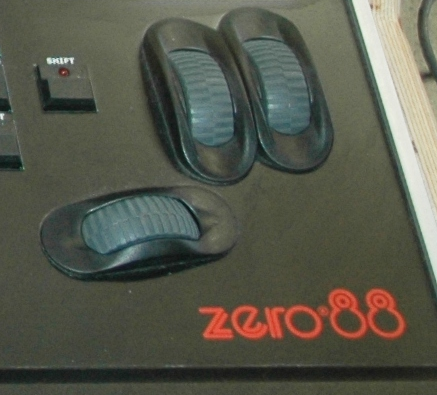
[Top of Section] [Top of Page] [Theatre Lighting Contents]
The consoles discussed so far are largely the varieties which are most common in venues such as small theatres or school/village halls. However, professional environments often demand a greatly superior level of control and therefore utilise even more sophisticated control consoles to those discussed thus far.
Such advanced consoles are typically not orientated around slider control. Instead, a numerical keypad can be used to input percentage intensities to specific ranges of DMX dimmer addresses. Encoder wheels are included to program moving-head lights as well. Furthermore, the internal workings of such a console closely resemble those of a desktop computer, containing items such as a full PC motherboard and hard drive in order to allow for efficient computerised operation. The presence of a hard drive also allows for the storage of many cue lists for many different productions simultaneously. This is of great use to large venues which may have multiple different shows running concurrently at different times of day.
The presence of a high capacity hard drive in such consoles allows for the internal storage of a database of all common DMX devices from common manufacturers and their specifications. This is of great use when configuring the lighting equipment for a show since complex multi-parameter devices may be addressed and configured for desk control simply by recalling the database record corresponding to a particular fixture; this loads the necessary DMX parameters directly into the show file and rehearsal programming can then begin immediately. This is instead of manually configuring each address of control for each different parameter of the fixture as would be the case with more basic consoles. The database may periodically be updated to account for the release of new fixtures by way of firmware updates, issued by the console manufacturer.
DMX device databases also allow for the precise control of devices such as colour-variable LED lights. Whereas when controlled from a more basic DMX console, each of the three optical primary colours is varied by a crude slider (see S1.4 - DMX Addressing of LED Fixtures), a professional console may include an on-screen "colour picker" similar to those used for computer graphics software packages. By selecting colours from this picker using a keyboard/mouse connected to the console, the necessary DMX values for each primary optical colour corresponding to the overall selected colour are automatically encoded and sent directly to the fixture with the result that the fixture instantly switches to the selected colour with no need for the tricky adjustment of multiple sliders. This makes the live adjustment of colours during a show (without pre-programmed cues) much easier.
Since it is becoming increasingly rare for large theatrical venues to operate exclusively from incandescent dimmed fixtures, it is the case that almost all modern consoles intended for professional theatrical use include ample provision, such as encoder wheels and the aforementioned colour picking techniques, for the control of intelligent light fixtures as well as that of standard dimmer packs and their corresponding incandescent lights. Consoles intended for larger venues where the use of a single DMX universe may impose restrictions on the maximum number of possible fixtures often include two DMX output ports such that two independent universes may receive control from a single console, thus doubling the maximum number of possible DMX control addresses.